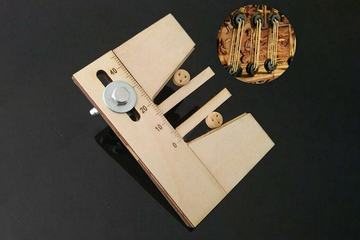I see, I didn’t understand this thing before!
Understanding CO2 Laser Machines
Laser engravers and cutters have become increasingly accessible and popular, transforming the way we handle personalized projects and small-scale manufacturing. They are used for a myriad of applications, from enhancing home décor to creating customized gifts, and even as a means for generating additional income through online sales.
In the expansive world of laser engraving, three primary types of laser engravers are predominantly used: diode, CO2, and fiber laser engravers. Each of these laser types has distinct properties, advantages, and limitations, making them suitable for different materials and applications.This passage hopes to help you to learn about one of the laser engravers, carbon dioxide laser engraver. If you are interested in purchasing a CO2 laser engraver, you might want to explore these brands: Glowforge, Gweike Cloud, OM Tech, xTool P2, etc.
How CO2 Laser Engravers Operate
CO2 laser engravers are powerful tools that use a carbon dioxide gas mixture, energized by electricity, to produce a high-intensity laser beam. This beam, when focused onto a material's surface, alters its properties or appearance, resulting in precise engraving, marking, or cutting. A CO2 laser engraver contains a tube filled with a gas mixture, primarily carbon dioxide, along with nitrogen, hydrogen, and helium. When electricity is applied, it excites the gas mixture, causing it to emit photons. These photons are then amplified and focused through mirrors and lenses to create a sharp, intense laser beam. This beam can be precisely controlled and directed onto the material to engrave intricate designs or make clean cuts.
Materials Suitable for CO2 Lasers
CO2 lasers are highly adaptable, capable of working with a diverse range of non-metallic materials. They are commonly used for:
Wood: Creating detailed carvings, signage, and artistic pieces.
Acrylic: Producing clear and polished edges, ideal for signs, display cases, and awards.
Fabric: Cutting and engraving for fashion, upholstery, and interior design.
Glass: Engraving elegant designs for decorative or functional purposes.
Leather: Crafting detailed patterns and text on belts, wallets, and accessories.
Paper: Intricate cutting for invitations, models, and artistic creations.
Advantages of Precision and Quality
The precision of CO2 laser engraving is astonishing. The laser beam, which can be as thin as 0.1mm, allows for incredibly detailed and precise work. This accuracy is crucial for complex designs in jewelry, detailed architectural models, and high-quality engravings on delicate materials.
Pros and Cons of CO2 Laser Engravers
Pros:
Versatility: They can handle a wide range of non-metal materials, making them ideal for diverse projects.
Precision: Excellent for intricate designs, allowing for detailed and complex engravings.
Adaptability: With models ranging from small desktop units to large industrial machines, they fit various scales of operation.
Cons:
Limited Metal Engraving: CO2 lasers are less effective on metals, requiring additional treatment or coatings for effective engraving.
Regular Maintenance: They need consistent upkeep of mirrors, lenses, and alignment for optimal performance. Once damage occurs, the cost of replacement is relatively high.
Energy Usage: Higher power models can be more energy-intensive, impacting operational costs.
Choosing and Maintaining Your Machine
When selecting a CO2 laser engraver, it’s essential to consider the intended use, the types of materials to be engraved, workspace constraints, and budget. The price of these machines varies widely, influenced by their size, power, and features. Proper maintenance is crucial for their longevity and includes regular cleaning of optical parts and ensuring proper alignment and calibration. Safety is paramount when operating CO2 laser machines. Adhering to safety guideline, such as using protective eyewear and maintaining adequate ventilation, is also vital, especially in shared or educational environments. The work area should be well-ventilated, especially when engraving materials that might emit fumes. Understanding the machine's operation, including its safety features and emergency stops, is essential for safe usage.
In conclusion, the CO2 laser engraver is a surprisingly versatile tool capable of changing a wide range of non-metallic materials into beautifully engraved pieces. It's the ideal tool for those looking to work with wood, acrylic, glass, fabric, and even coated metals. While it demands a bit more care due to its gas-based technology, the investment in maintenance is a small price to pay for the broad spectrum of applications it offers. The CO2 laser engraver is a useful ally in bringing your innovative dreams to reality, whether you're a hobbyist, a small business owner, or an artist.
Next, we'll continue to update our series, delving into the remaining types of laser engraving machines: diode laser engravers and fiber laser markers. Stay tuned with Creatorally for the latest updates. To tailor our forthcoming content to your interests, email us at rollandberry2020@gmail.com. with your preferences.
Thank you, author!
Getting older, I’m having a bit of trouble keeping up with these new concepts. However, this article helped fill in some of the gaps in my knowledge.




3 comments